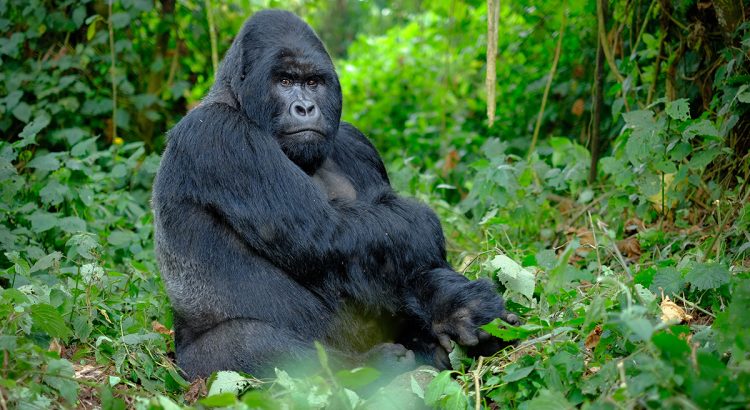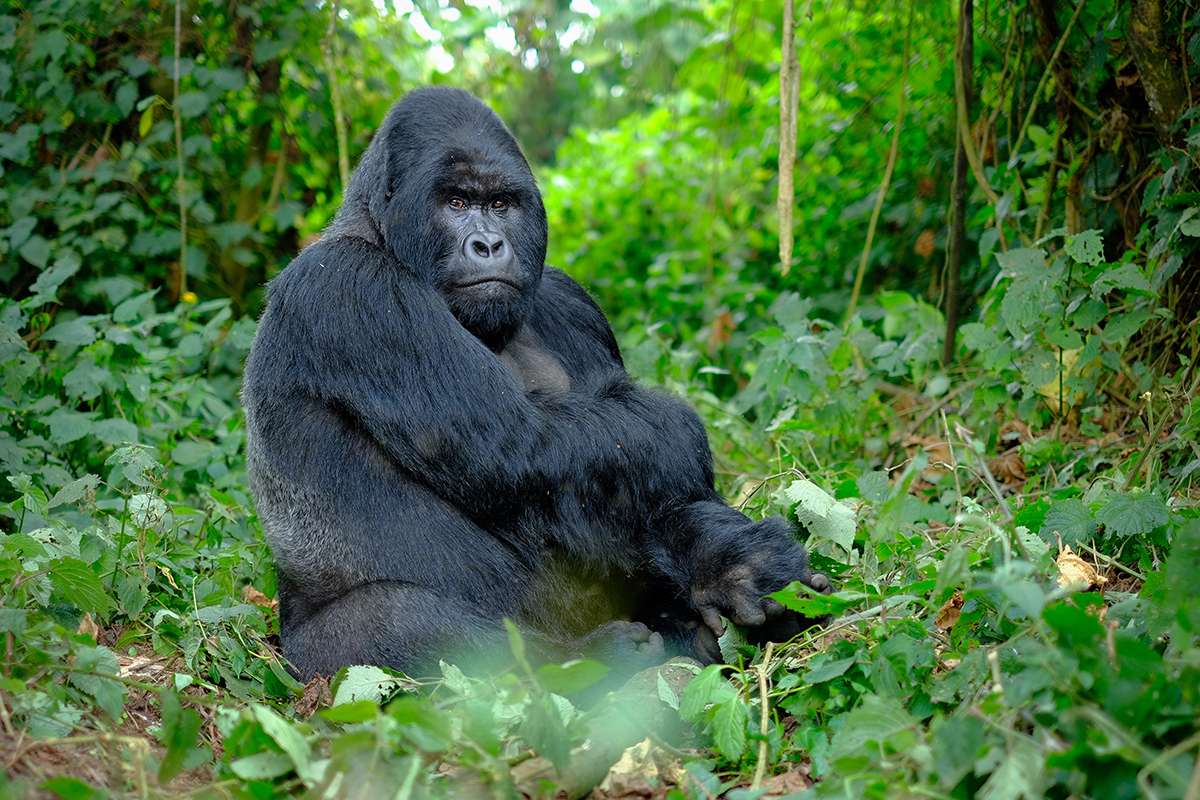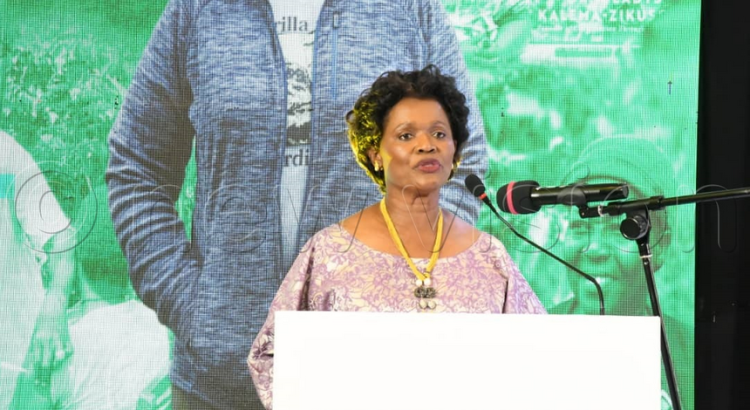SOURCE: Protect Great Apes
Category: Press Release

Keeping Gorillas and People Healthy
Nearly three decades ago, Dr. Gladys Kalema-Zikusoka became Uganda’s first national wildlife veterinarian. At the time, hardly any women worked in conservation in the country and no female rangers operated in the field. At just 25 years old, and freshly-graduated from the Royal Veterinary College of London, she established the veterinary unit at the Uganda Wildlife Authority (UWA). She’s been a trailblazer ever since, working to protect the country’s wildlife — in particular, its declining mountain gorilla populations — while safeguarding local communities as well. She has been instrumental in popularizing a community-based “one health” approach to conservation.
Her early years as a wildlife vet with UWA laid bare the reality that many people, mostly underprivileged, share habitats with gorillas in Uganda’s montane forests and that has health implications for the great apes. For example, a 1996 scabies outbreak among gorillas in Bwindi Impenetrable National Park pointed to human-wildlife disease transmission. Caring for the diseased animals left Kalema-Zikusoka contemplating the importance of supporting the health of local communities, too.
First-hand experiences like this planted the seeds of Kalema-Zikusoka’s pioneering conservation work and inspired her to found Conservation Through Public Health (CTPH) in 2003 to address badly-overlooked health and sanitation needs in forest-adjacent communities, mitigate disease transmission from humans to gorillas, and support local livelihoods.
Some 20 years later, her efforts are paying off. From around 650 in 1996, the total mountain gorilla population has grown to over 1,000.
Kalema-Zikusoka has been widely recognized for her work, earning the 2009 Whitley Gold Award, which celebrates advocates of biodiversity, and UNEP’s 2021 Champion of the Earth for Science and Innovation. She was named one of BBC’s 100 inspiring and influential women in 2023 for her work to mitigate the impacts of climate change on gorillas. Her memoir, Walking with Gorillas, was published last year. Kalema-Zikusoka spoke with me recently about the importance of African-led conservation work on the continent, the unique role of women in the field, and the dangers of overreliance on tourism dollars to support environmental campaigns.
What are the key lessons you have learned over the years about sustainable conservation with long-lasting impact?
As an NGO, we’ve learned the importance of engaging the government through meaningful discussions and not just telling the government what it should be doing. I worked for the government for four-and-a-half years, and NGOs can sometimes be seen as arrogant. Have a discussion with those in government to explain the mission of the organization and what you are trying to achieve. [At CTPH] we organize strategic planning workshops and consultations to get buy-in, otherwise the government will not support the work.
It is also important to engage communities that interact directly with the wildlife and stand to benefit the most from living next to wildlife. Don’t force your ideas down people’s throats, but discuss the problem and let them come up with the solution. Without meaningful engagement, local people cannot become conservationists and protectors of wildlife.
Why are African-led efforts in environmental issues important?
Because that’s the only way conservation efforts will be implemented and work in the long term. Many people have come in and out of Africa imposing their ideas, and some are very good. But without African leadership, these programs are unlikely to last long. Investments are needed to train local people; otherwise they will not realize their potential. Africans in conservation programs can become project leaders or become local and national leaders. It is important to develop local leadership. If not, talented people will leave conservation and join other sectors with better opportunities for career promotion.
In what ways are you driving African-led initiatives in great ape conservation?
For many years, I attended conferences of the International Primate Society (IPS) in Europe or America to talk about primates in Africa, but there were hardly any Africans present. They couldn’t afford to travel or were not promoted enough at their organizations to speak at international conferences. For this reason, I started the African Primate Society (APS) in 2016, with other primatologists, including Dr. Inza Kone from Ivory Coast, Dr. Ekwoge Enang Abwe from Cameroon, Dr. Riashna Sithaldeen from South Africa, and Dr. Rachel Ikemeh from Nigeria.
The first APS conference in Ivory Coast had about 150 delegates, and 80 percent were African primatologists. They gave scientific talks, presented abstracts, and spoke about their work. At the Uganda conference in 2019, 85 percent of the 300 delegates were native Africans. I believe the public in Nigeria, for example, is going to be more convinced by a Ugandan researcher than by somebody coming from [the West]. That is why it is really important to have more African-led conservation efforts.
What is the unique role of women in wildlife management, conservation, and veterinary work?
When I started, there were hardly any women in conservation and no female rangers. Ugandan society did not encourage women to live in remote areas and do dangerous work, like following wildlife or carrying guns.
But conservation requires collaboration with many sectors, such as affected communities, local authorities, the government, the private sector, NGOs, community-based organizations, and others. At CTPH we collaborate with healthcare workers to improve community well-being and we work with sectors such as environmental, tourism, and farming to achieve our conservation goals. I find that women are more holistic, less competitive, and willing to work with different stakeholders and to learn from others.
In villages and communities, women are more engaged in healthcare. Conservation linked to healthcare gets more women involved in wildlife protection, which helps us to achieve gender balance. At meetings with reformed poachers, some wives admitted to encouraging their husbands to poach animals to put food on the table. So, it is not enough to look at wildlife. We must look at the structures of communities and families and what drives people to do what they do.
Women invest in families and communities for the long term. They are willing to speak up in a crowd and want to educate their girls because they now see female role models and women doing things out there. Today, 4 out of 15 wildlife vets in Uganda are women and approximately 20 percent of wildlife rangers are female. If you look at primate research around the world, the longest studies were started by women. Dr. Jane Goodall began chimpanzee work in Gombe, Tanzania, in 1960. Birut Galdikas’ research on orangutans in Borneo is coming on 50 years now. The late Dian Fossey’s gorilla study program in Rwanda is still going strong [nearly 60 years after she started it]. Women are more likely to stick to one thing and see it through.
Tourism remains a key economic driver. How do you see the balance with conservation going forward?
I would say that tourism is still a necessary evil. Conservation efforts in partnership with tourism are bigger and more sustainable because of the tourism funds. In Uganda, by an act of Parliament, 20 percent of national park entry fees and [funds from a] $10 per gorilla permit in Bwindi [Impenetrable National Park] goes to the local community.
Tourism reinforces government efforts in monitoring wildlife and uplifting communities. Ninety percent of tourism staff in Bwindi are from the local community. Tourism that engages local communities sustains conservation efforts better because families benefit from viable income, and they protect animals rather than hunt them.
It is also important to promote local entrepreneurship, such as people who make crafts, sell food, provide accommodation, and do community walks. Our organization brings visitors to the Gorilla Conservation Coffee farmers because a responsible tourist does not only visit gorillas but spends time with the community. When the community meets the tourists, they are less likely to poach.
The negative side of tourism, however, is overreliance, and the pandemic showed this. When tourism stopped, poaching was high in places like Bwindi where people were totally dependent on tourism to survive. A well-known silverback gorilla called Rafiki was poached in 2020, which would not have happened except for the pandemic. We realized that many people were not getting enough to eat and had gone back to bushmeat hunting. Our solution was to provide fast-growing crop seedlings, and the locals have continued to plant even when tourism returned. The pandemic was a wake-up call about relying solely on tourism for conservation efforts.
We must also take care that tourists do not make gorillas and chimpanzees sick with respiratory diseases. During the pandemic, we led advocacy efforts with the government for visitors to wear masks when visiting great apes, to keep a respectable distance, and to make sure tourists are healthy by taking their temperatures. The practice has continued beyond the pandemic to protect wildlife from human diseases that could wipe them out.
Sustainability is key for wildlife conservation. How successful has upscaling the Village Health and Conservation Teams (VHCT) initiative, which trains community volunteers to deliver public health services and conservation education to local communities, been?
What makes VHCTs sustainable is using existing health structures. Community health workers are everywhere, and we can train them in conservation services as well. The system is set up so that NGOs and others who are interested can support village health workers or conservation work. Wherever you have health issues you also have environmental issues.
In Mount Elgon National Park, in eastern Uganda, we don’t have an NGO partner on the ground, but we work with the local government. This comes with its challenges, but we structure it in such a way that the initiative is owned by the government. In the Budongo area of western Uganda, we work with the Jane Goodall Institute, which has really embraced the program. The program has expanded to Virunga National Park in the DRC. VHCT staff in the Mount Tshiabirimu and Mikeno areas have continued working through the rebel activities, visiting homes whenever it is safe, to improve health, sanitation, and hygiene. Somehow we have kept it going, although we need more families [participating] in DRC like in Uganda. We are looking to introduce VHCTs in other countries with gorillas. The challenge is introducing and sustaining the project without needing to provide additional funding.
The current global gorilla population is just over 1,000. What is the ideal number and what needs to be done to achieve this?
We’re glad the gorilla population is growing, but they are still very few. Continued efforts are needed through conservation, veterinary care, and community engagement. Healthcare is a good entry point for conservation programs because then people feel that you don’t only care about wildlife. As community health improves, gorillas will fall sick less often from human diseases.
We must continue looking at livelihoods and making sure communities benefit through eco-tourism. CTPH has created a policy brief on channelling tourism resources to conservation in all African countries with great apes, alongside mask-wearing, safety, and encouraging tourists to visit communities.
More space is needed for gorillas because their numbers are growing, but there isn’t enough land. We must expand protected areas by encouraging people to sell their land to increase gorilla habitats. We have done it in Rwanda and are starting to work on it in Uganda.
How does the Ugandan public view gorillas and wildlife conservation?
Generally, the public is more appreciative of our natural assets, habitats, and conservation efforts, especially around gorillas. People appreciate the role of gorillas in bringing back tourism and lifting people out of poverty. When CTPH started, people wondered why we were integrating human health with animal health and conservation. Now they realize it’s important to do it together for long-term outcomes. We now have a gorilla picture on the 50-shilling note.
Your career has not been easy. What keeps you going?
The feeling that I’m making a difference, that the situation for wildlife is improving, and that communities are appreciating wildlife more. Seeing more youth and women in conservation gives me hope. Watching the number of mountain gorillas growing means our work is making a difference and it is worth continuing with the struggle. Local leadership can improve, but when communities that once hated wildlife now appreciate it and want to see tourists in parks, it gives me hope.
Having Ugandan role models championing conservation efforts makes people want to protect wildlife and realize it is not for foreigners but for us, our children, and grandchildren. I want to encourage more role models, especially women in leadership and conservation, and to challenge things even if it involves going against societal norms. Also, my faith in God keeps me going, because it can be depressing when things go wrong. This work is a calling, and we just have to keep going.
This interview has been edited for length and clarity.

When gorillas and humans live together
30 May 2024

How can gorilla conservation be combined with the public health of the local population in Uganda? Walking with Gorillas will share her personal experience on this issue at an event to be held on Monday, 3 June at 6.30 p.m. in Uni Mail. The wildlife specialist will return to her journey and vision of gorilla conservation, which is based on the coexistence of humans and animals.
Lecture by Gladys Kalema-zikusoka, Conservation Through Public Health
Monday 3 June – 6.30 p.m. – Uni Mail, room MR280






